| “ | I believe we are slowly turning into a socialist government. The government is continually growing bigger and more powerful and the people need to prepare to defend themselves against government control. | ” |
— McVeigh
| ||
Timothy James "Tim" McVeigh, a.k.a. "The Oklahoma City Bomber", was a homegrown terrorist, mass murderer, and hacker.
Background
| “ | AMERICA IS IN DECLINE....Do we have to shed blood to reform the current system? | ” |
— McVeigh
| ||
McVeigh was born on April 23, 1968, in Lockport, New York, the middle child of William "Bill" McVeigh, who worked at a car radiator plant, and Mildred "Mickey" McVeigh. He grew up in Pendleton, New York, a small town not far from the Canadian border. His former neighbors later described as a cheerful, pleasant person. His grandfather, Eddie McVeigh, introduced him to hunting and firearms when he was young and gave him a .22 rifle when he was thirteen. He claimed to have been bullied in high school and to have created a fantasy world for himself in which he could exact revenge on his bullies. When he was a teenager, his mother left the family, and in 1986, his parents divorced. After graduating high school, he briefly attended the Bryant & Statton College, but dropped out. He began hacking into government computers from his Commodore 64. He also became obsessed with the novel The Turner Diaries, which was written by William Luther Pierce, the then-leader of an American white nationalist movement, and is about an armed uprising against the U.S. government, followed by a campaign of ethnic cleansing and eventual world conquest committed by the insurgents, although McVeigh didn't agree with the book's racial and genocidal ideas. At one point in the novel, the protagonist destroys the FBI office in Washington with a bomb in a truck, not unlike the way McVeigh later carried out his bombing. A favorite movie of McVeigh's was, according to TruTV, Red Dawn, in which the U.S. is invaded by Soviet and Cuban forces, and civilians begin a guerrilla war against them (the movie has been noted for its appeal to right-wingers because of its pro-gun message). He was also interested in gun rights and the Second Amendment.
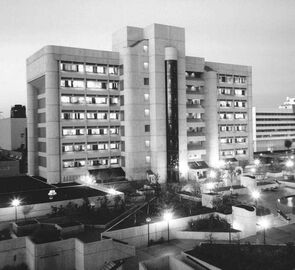
The Murrah building, the target of the attack.
In May 1988, at the age of twenty, he enlisted in the U.S. Army as a gunner (though he had hoped for a position in the Green Berets) and served in the Gulf War. He signed up to join the Special Forces, but was deemed unsuitable for them during psychological examinations. Shortly afterwards, he decided to leave the Army and was honorably discharged in 1991. He was awarded a Bronze Star Medal for his service. Back in Buffalo, McVeigh worked at a rent-a-cop agency, but eventually left the area because he thought its political views were too liberal. He started driving around and visiting old Army friends. A hard blow for him was when he was informed that he had been overpaid ca. $1,000 during his time in the Army. He took up gambling even though he had financial problems and even left the National Rifle Association because he thought their stances on gun rights were too weak. He frequently voiced his contempt for the U.S. government and was a conspiracy theorist. In 1993, he packed up all his belongings and simply drove around with them. The same year, the Waco siege began when the ATF attempted to serve a search warrant for the grounds of the Branch Davidians' ranch on suspicion of firearm law violations. McVeigh took a great interest in the situation and even appeared near the site of the siege, handing out gun right and anti-government leaflets and bumper stickers. On April 19th, the siege ended when a fire broke out and many of the Branch Davidians, including its leader David Koresh, were burned to death. McVeigh was enraged and began planning a strike on the U.S. government, which, he believed, was having too much control of its citizens. He recruited Terry Nichols, a friend from his Army days, to his cause. McVeigh would claim to have committed the bombing out of retaliation against the federal government for their handling of the aforementioned siege.
The Bombing, Arrest, and Execution
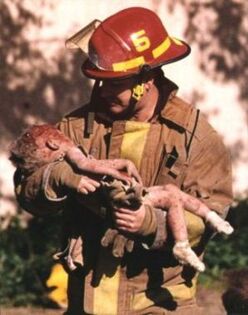
Famous photo of firefighter Chris Fields holding the dying infant Baylee Almon.
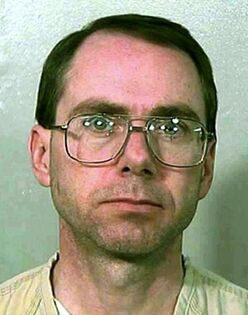
Terry Nichols.
| “ | I didn't define the rules of engagement in this conflict. The rules, if not written down, are defined by the aggressor. It was brutal, no holds barred. Women and kids were killed at Waco and Ruby Ridge. You put back in [the government's] faces exactly what they're giving out. | ” |
— McVeigh justifying the deaths of women and children during the bombing
| ||
In April 1993, after the Waco siege, McVeigh visited Nichols, who taught him how to construct explosive devices from simple, easily accessible components. He began planning a strike on the U.S. government, intending to attack some federal building. Prior to that, he had considered murdering various people involved in legal actions related to the Waco siege and the Ruby Ridge standoff. Nichols, who was also anti-government, agreed to aid him. Over the following two years, they planned the attack together, choosing the Alfred P. Murrah Federal Building in Oklahoma City, Oklahoma, as their target. They had help from Michael Fortier, who had served with both of them in the U.S. Army, and his wife, Lori. Both were told of the plan, although they didn't tell the authorities. Michael also helped them transport weapons and Lori made McVeigh a fake driver's license. It is also assumed that McVeigh participated in several bank robberies with a gang based in Elohim City, Oklahoma, in order to fund for his attack. On April 19, 1995, the two-year anniversary of the day a fire broke out on the Branch Davidians' compound at Waco Ridge and the siege ended, McVeigh carried out their plan.
Using a fake name, McVeigh rented a Ryder truck loaded with an improvised bomb. When the bomb was finished, Nichols went home to Herrington, Kansas while McVeigh drove away with the bomb to carry out the bombing. The truck was parked in the building's parking area in the morning when people started arriving for work. At 9:02 a.m., the bomb exploded, completely destroying the building and killing 168 people. Over 800 additional people were injured. By then, McVeigh was already on the road in his 1977 Mercury Marquis. An hour and a half later, he was pulled over by an Oklahoma State Trooper on the I-35 75 miles away from the bomb site for speeding and driving a car without license plates. When the officer spotted a 9mm Glock in the glove compartment, McVeigh was arrested for speeding and firearm offenses. Over the next few days, the investigation of the bombing proceeded. It was initially believed to be the work of some terrorist organization, possibly one connected to the World Trade Center bombing two years earlier, or a drug cartel. When the FBI, who code-named the investigation "OKBOMB", traced the truck back to McVeigh through a motel he had stayed at and accidentally signed his real name, they began investigating him for the bombing. On April 21, Nichols learned that he was being chased as well and turned himself in.
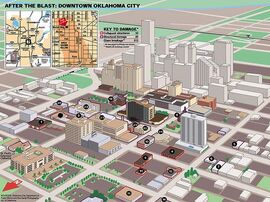
Map of Oklahoma City, indicating the Murrah building and nearby buildings that were also destroyed or damaged.
The investigators found heaps of evidence implicating both McVeigh and Nichols in the bombing, such as bomb-making supplies, books on how to do it, a hand-drawn map of Oklahoma City with the Alfred P. Murrah building and the location of McVeigh's getaway car marked, and a copy of Hunter, a book written by the same author as The Turner Diaries, on Nichols' property. Parts of the truck used to deliver the bomb which were launched by the blast were traced back to McVeigh, as were an alias he had used to rent it. He also matched a composite of one of two unidentified males seen on the scene of the bombing (the other man turned out to have been an innocent by-passer). After three days on trial, McVeigh was found guilty of using a weapon of mass destruction, conspiracy to do the same, destruction by use of explosives and eight counts of first-degree murder and was sentenced to death. While on death row, McVeigh wrote several critical essays. One was titled An Essay of Hypocrisy and criticized the U.S.'s foreign policy during the invasion of Iraq. On June 11, 2001, he was executed by lethal injection at the Federal Correction Complex in Terre Haute, Indiana. His final statement was a handwritten statement which quoted the poem "Invictus", ending with the lines "I am the master of my fate, I am the captain of my soul". He was thirty-three years old when he died.
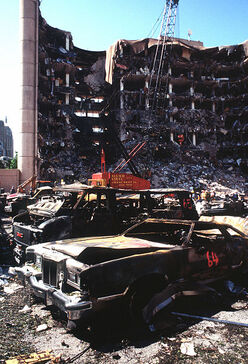
The Murrah building, two days after the bombing.
Aftermath
After the bombing, several people who had aided McVeigh in the bombing in some way were also prosecuted. Nichols was found guilty of being an accomplice and sentenced to life without the possibility of parole, a sentence he is still serving at the ADX Florence Supermax Prison in Florence, Colorado, where Ted Kaczynski and Eric Rudolph are both also incarcerated. The Fortiers were also both indicted. Michael, who had known of the plan but failed to report it to the authorities, was sentenced to twelve years in prison, though he had been a witness against McVeigh and Nichols during the trial. He was released in 2006, after serving eight years of his sentence, and entered the Witness Protection Program. Lori was granted immunity for her testimony. In 1997, a memorial dedicated to the victims of the bombing was established in Oklahoma City. Among its features are The Gates of Time, two bronze gates with the time of the bombing and the minutes before and after inscribed into them, and the Field of Empty Chairs, which consists of 168 empty chairs representing the 168 people who died in the bombing. The only standing wall of the Alfred P. Murrah building, the southeast corner and part of the southern wall, has been turned into the Survivors' Wall, where the names of over 600 survivors of the attack are engraved.
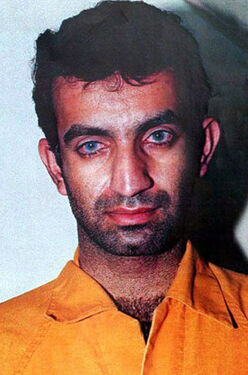
Ramzi Yousef.
Many conspiracy theories have surfaced in the wake of the bombing:
- One claim was that Ramzi Yousef, the 1993 World Trade Center bomber, had been with Terry Nichols, McVeigh's accomplice, in the Philippines. The theory goes on to state that Nichols learned how to make bombs from Yousef and his al-Qaeda associates. In reality, Nichols was meeting his Filipino mail-order bride during the time while Yousef was concocting airliner bombing plots.
- Some claim the government had staged the bombing as a false-flag operation in order to crack down on militia movements. Some argued that the truck bomb wasn't powerful enough to crush the columns that supported the building, and that additional explosives inside the building were used in the attack.
- As many as ten eyewitnesses reported seeing Timothy McVeigh with an accomplice, known only as "John Doe #2", in the area of the Murrah Building that morning and also the day he rented the van used in the bombing. The man is described as a white male wearing dark glasses, a dark blue jacket, a black shirt, a purple hat with flame logos on it, and a tattoo on his left arm. One witness reported seeing two Middle Eastern men running away from the building shortly before the blast, with another claiming having almost been run over by the same men. Both men were described as six feet tall with athletic builds and wearing dark sweat-jackets, with one of them aged in his late 20s or early 30s.
Modus Operandi
| “ | The truck rental — $250. The fertilizer was about... it was either $250 or $500. The Nitromethane was the big cost. It was like $1,500. Actually, lemme see, 900, 2,700,... [sic] we're talking $3,500 there... Lets [sic] round it up. I just gave you the major expenses, so go to like five grand... what's five grand? | ” |
— McVeigh on the total cost of materials used to construct the truck bomb
| ||
McVeigh destroyed the Alfred P. Murrah Federal Building with a Ryder truck loaded with an improvised bomb called a "fertilizer bomb" (ammonium nitrate is often used as a high-nitrogen fertilizer). It consisted primarily of 108 bags of ammonium nitrate and three 210-liter barrels of nitromethane, a kind of fuel used in drag racing, among several other things.
Profile
| “ | With Oklahoma City being a counterattack, I was only fighting by the rules of engagement that were introduced by the aggressor. Waco started this war...Hopefully Oklahoma would end it. | ” |
— Timothy McVeigh, 2001
| ||
The long hours in a dead-end job, the feeling that he did not have a home, and his failure to establish a relationship with a woman brought McVeigh to the breaking point. He sought romance, but was rejected by a coworker and still felt nervous around women. He felt he brought too much pain to his loved ones. He grew angry and sexually frustrated at his difficulties in finding a girlfriend and took up obsessive gambling. Most people who knew McVeigh remember him as being withdrawn, with a few describing him as an outgoing and playful child who withdrew as an adolescent. McVeigh said that the Army taught him how to switch off his emotions. Michelle Rauch, who had interviewed McVeigh about the Waco siege while it was still underway, reported on Zero Hour that he was worried about the intense presence of the government on "One Man and his followers' private lives", seeing as a sign of more to come. McVeigh was also very articulate, passionate and intelligent. McVeigh was described as polite, hardly ever swore and did as he was told without question, even when being arrested an hour after the bombing.
Van Zandt, a psychological profiler who had worked as chief FBI negotiator at Waco, Texas (which was the site of the Branch Davidian siege), noted the date of the attack was exactly two years to the day when the deaths at Waco had occurred. In fact, within hours of the bombing, many people immediately noted the date. He believed the perpetrator would be white, male, and in his twenties. Furthermore, he theorized the suspect would be a man with a military background and possibly a member of a fringe militia group. His assessment would be proven correct as the investigation progressed. Terrorism expert Louis R. Mizell, Jr., noticed that the date coincided with that of Patriots' Day, which was the anniversary of the Battles of Lexington and Concord during the American Revolutionary War, events revered by the militia movements.
Known Victims
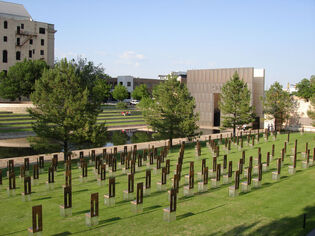
The Oklahoma City Memorial dedicated to the victims of the bombing.
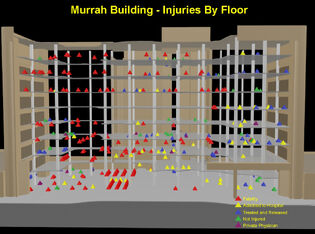
Map denoting the locations of the casualties of the bombing.
Fatalities
- Fatalities on the ninth floor:
- Five killed at the Drug Enforcement Administration office:
- Shelly Bland, 25
- Carroll Fields, 48
- Rona Kuehner-Chafey, 35
- Carrie Lenz, 26
- Kenneth McCullough, 36
- Six killed at the U.S. Secret Service office:
- Cynthia Brown, 26
- Donald Leonard, 50
- Mickey Maroney, 50
- Linda McKinney, 47
- Kathy Seidl, 39
- Alan Whicher, 40
- Five killed at the Drug Enforcement Administration office:
- Fatalities on the eighth floor:
- Fifteen killed at the U.S. Department of Housing and Urban Development office:
- Ted Allen, 48
- Peter Avillanoza, 56
- David Burkett, 47
- Donald Burns, Sr., 63
- Kimberly Clark, 39
- Susan Ferrell, 37
- Dr. George Howard, 45
- Antonio Reyes, 55
- Lanny Scroggins, 46
- Leora Sells, 57
- Jules Valdez, 51
- David Walker, 54
- Michael Weaver, 54
- Frances Williams, 48
- Clarence Wilson, Sr., 49
- Fifteen killed at the U.S. Department of Housing and Urban Development office:
- Fatalities on the seventh floor:
- Nineteen killed at the U.S. Department of Housing and Urban Development office:
- Diane Althouse, 45
- Andrea Blanton, 33
- Kim Cousins, 33
- Diana Day, 38
- Castine Deveroux, 49
- Judy Fisher, 45
- Linda Florence, 43
- J. Colleen Guiles, 59
- Thompson Hodges, Jr., 54
- Ann Kreymborg, 57
- Teresa Lauderdale, 41
- Mary Leasure-Rentie, 39
- James McCarthy II, 53
- Betsy McGonnell, 47
- Patricia Nix, 47
- Terry Rees, 41
- John Stewart, 51
- John Van Ess III, 67
- Jo Whittenberg, 35
- Nineteen killed at the U.S. Department of Housing and Urban Development office:
- Fatalities on the sixth floor:
- Two killed at the U.S. Marine Corps Recruiting office:
- Sergeant Benjamin Davis, U.S.M.C., 29
- Captain Randolph Guzman, U.S.M.C., 28
- Two killed at the U.S. Marine Corps Recruiting office:
- Fatalities on the fifth floor:
- Seven killed at the U.S. Department of Agriculture office:
- Olen Bloomer, 61
- James Boles, 50
- Dr. Margaret Clark, 42
- Richard Cummins, 55
- Doris Higginbottom, 44
- Carole Khalil, 50
- Rheta Long, 60
- The U.S. Department of Housing and Urban Development office: Paul Broxterman, 42
- Two killed at the U.S. Customs Office office:
- Paul Ice, 42
- Claude Medearis, SSA, 41
- Seven killed at the U.S. Department of Agriculture office:
- Fatalities on the fourth floor:
- Eleven killed at the U.S. Department of Transportation office:
- Lucio Aleman, Jr., 33
- Mark Bolte, 28
- Michael Carrillo, 44
- Larry Jones, 46
- James Martin, 34
- Ronota Newberry-Woodbridge, 31
- Jerry Parker, 45
- Michelle Reeder, 33
- Rick Tomlin, 46
- Johnny Wade, 42
- John Youngblood, 52
- Eight killed at the U.S. Army Recruiting Battalion office:
- Sergeant First Class Lola Bolden, U.S.A., 40
- Karen Carr, 32
- Peggy Holland, 37
- John Moss III, 50
- Victoria Sohn, 36
- Dolores Stratton, 51
- Kayla Titsworth, 3
- Wanda Watkins, 49
- Eleven killed at the U.S. Department of Transportation office:
- Fatalities on the third floor:
- Five killed at the Defense Security Service office:
- Harley Cottingham, 46
- Peter DeMaster, 44
- Norma Johnson, 62
- Larry Turner, 42
- Robert Westberry, 57
- Twenty-one killed at the Federal Employees Credit Union office:
- Woodrow Brady, 41
- Kimberly Burgess, 29
- Kathy Finley, 44
- Jamie Genzer, 32
- Sheila Gigger-Driver, 28
- Linda Housley, 53
- Robbin Huff, 37
- Christi Jenkins, 32
- Alvin Justes, 54
- Valerie Koelsch, 33
- Kathy Leinen, 47
- Claudette Meek, 43
- Frankie Merrell, 23
- Jill Randolph, 27
- Claudine Ritter, 48
- Christy Rosas, 22
- Sonja Sanders, 27
- Karen Shepherd, 27
- Victoria Texter, 37
- Virginia Thompson, 56
- Tresia Worton, 28
- Five killed at the Defense Security Service office:
- Fatalities on the second floor:
- Nineteen killed at the America's Kids Child Development Center office:
- Baylee Almon, 1 (was rescued, but died from sustained injuries)
- Danielle Bell, 15 months
- Zachary Chavez, 3
- Dana Cooper, 24
- Anthony Cooper II, 2
- Antonio Cooper, Jr., 6 months
- Aaron Coverdale, 5
- Elijah Coverdale, 2
- Jaci Coyne, 14 months
- Brenda Daniels, 42
- Taylor Eaves, 8 months
- Tevin Garrett, 16 months
- Kevin Gottshall II, 6 months
- Wanda Howell, 34
- Blake Kennedy, 1
- Dominique London, 2
- Chase Smith, 3
- Colton Smith, 2
- Scott Williams, 24
- Nineteen killed at the America's Kids Child Development Center office:
- Fatalities on the first floor:
- Forty killed at the Social Security Administration office:
- Teresa Alexander, 33
- Richard Allen, 46
- Pamela Argo, 36
- Saundra Avery, 34
- Calvin Battle, 62
- Peola Battle, 56
- Oleta Biddy, 54
- Cassandra Booker, 25
- Carol Bowers, 53
- Peachlyn Bradley, 3
- Gabreon Bruce, 3 months
- Katherine Cregan, 60
- Ashley Eckles, 4
- Don Fritzler, 64
- Mary Fritzler, 57
- Laura Garrison, 61
- Margaret Goodson, 54
- Ethel Griffin, 55
- Cheryl Hammon, 44
- Ronald Harding, Sr., 55
- Thomas Hawthorne, Sr., 52
- Dr. Charles Hurlburt, 73
- Jean Hurlburt, 67
- Raymond Johnson, 59
- LaKesha Levy, 21
- Aurelia Luster, 43
- Robert Luster, Jr., 45
- Reverend Gilbert Martinez, 35
- Cartney McRaven, 19
- Derwin Miller, 27
- Eula Mitchell, 64
- Emilio Tapia, 50
- Charlotte Thomas, 43
- Michael Thompson, 47
- LaRue Treanor, 55
- Luther Trenaor, 61
- Robert Walker, Jr., 52
- Julie Welch, 23
- W. Stephen Williams, 42
- Sharon Wood-Chesnut, 47
- Two killed in the General Services Administration office:
- Steven Curry, 44
- Michael Loudenslager, 48
- Forty killed at the Social Security Administration office:
- Fatalities in the surrounding areas:
- Rebecca Anderson, 37 (rescue worker; was fatally struck in the head by falling debris)
- Two killed at the Athenian Building:
- Anita Hightower, 27
- Kathryn Ridley, 24
- Two killed at the Oklahoma Water Resources Board Building:
- Robert Chipman, 51
- Trudy Rigney, 31
- Note: A leg that wasn't matched to any of the 168 victims was also found at the scene of the bombing. It has been suspected that the leg belonged to a 169th victim, but no other body parts were found.
Injuries
- P.J. Allen, 18 months
- Ernestine Clark
- Brandon Denny, 3
- Rebecca Denny, 2
- Tom Hall
- Sheila Kidder
- Nekia McCloud, 4
- Calvin Moser
- Christopher Nguyen, 5
- Amy Petty
- Susan Walton
- Richard Williams
- Joseph Webber, 1
- Over 667 other unnamed people
Notes
- When Anders Behring Breivik was arrested for the terrorist attack in Oslo, the media compared him to McVeigh. They are similar in several aspects; both were right-wing extremists who perpetrated their attacks as means of rebellion against the governments of their respective countries, both acted (mostly) alone, and both used bombs with fertilizer in their attacks (though Breivik's was used primarily as a diversion).
On Criminal Minds
McVeigh was mentioned (fairly briefly) in the Criminal Minds novel Killer Profile. In the episode Empty Planet, serial bomber Kenneth Roberts's use of the novel Empty Planet as a guide for his rampage appears to parallel McVeigh, who planned his attack copied from the white supremacist novel The Turner Diaries. His mugshot photo briefly appeared in the episode Won't Get Fooled Again along with his accomplice Terry Nichols and serial bomber Eric Rudolph. He was later mentioned by Kate alongside Tamerlan and Dzhokhar Tsarnaev as examples of terrorist bombers in the episode Hero Worship. He was later mentioned in The Capilano's.
McVeigh also appears to have been the basis for Mitchell Crossford in the sense that both were homegrown terrorists with extreme anti-government views, who committed attacks against the U.S. government as retaliation for the federal dismantling of notable religious cults, including the Waco siege. They also sought to attack a federal building with the aim to kill as many federal employees as possible (although McVeigh was successful in his attack whereas Crossford's was foiled). In addition, both had an accomplice who assisted them in their weapons (Mitchell was given the sarin gas by Johann Geitman, while McVeigh had Terry Nichols's help in constructing the fertilizer bomb).
McVeigh's mugshot is seen in the intro of each episode, next to David Rossi and when it shows the entire team. McVeigh also appeared next to Jason Gideon in the intros while he was still on the team. McVeigh was also mentioned in the Suspect Behavior episode Here is the Fire alongside George Metesky, Theodore Kaczynski, and Eric Rudolph as examples of bombers.
Sources
- Wikipedia:
- 101 Crimes of the Century (2008)
- TruTV Crime Library articles about McVeigh and the bombing
- About.com page about McVeigh's final words
- USA Today's list of the Oklahoma City bombing fatalities
- The Seattle Times article about survivors of the bombing
- New York Daily News article about survivors of the bombing
- Survivor Guidelines article about survivor Richard Williams
- Rense.com summary of survivor Calvin Moser
- CNN article about the bombing's fifteenth anniversary
- Oklahoma's Own News 9 archive of article relating to the bombing's fifteenth anniversary
- Baltimore City Paper article with quote
- Oklahoma City by Andrew Gumbel and Roger Charles
- Conspiracy? Ep. 9: Oklahoma City Bombing YouTube video
- The Oklahoma City Bombing & The Trial of Timothy McVeigh by Douglas O. Linder
